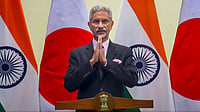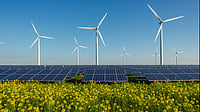
U.S. President Donald Trump is likely to propose a new blanket tariff of 15–20% on imports from countries without trade deals with the U.S., raising it from April’s 10% baseline.
With the August 1 deadline inching close, Trump signals preference for tariffs over formal agreements, escalating global trade tensions.
US President Donald Trump announced on Monday that he is likely to implement a blanket tariff ranging between 15% to 20%, on imports to the United States coming from countries that have still not negotiated any trade agreement.
As per a CNBC report, Trump said, “For the world, I would say it’ll be somewhere in the 15% to 20% range ... I just want to be nice.”
What is Trump’s Latest Blanket Tariff?
Representing an increase from the 10% baseline tariff announced by Trump in April this year, the latest figures appear to be significant. However, it may also have an impact on smaller countries, hoping that the tariff rate would be closer to 10%.
Earlier this month, US Commerce Secretary Howard Lutnick suggested that smaller nations, including “the Latin American countries, the Caribbean countries, many countries in Africa,” will have a baseline tariff of 10%.
However, on Monday Trump said that the country is going to be setting a tariff for essentially the rest of the world, and that’s what they’re going to pay if they want to do business in the United States. “…Because you can’t sit down and make 200 deals,” he added.
Trump’s comments come as many countries have not negotiated trade deals with the United States, days before his Aug 1 tariff deadline.
Tariff Instead of Trade Deals
With the deadline for trade deals looming closer, Trump administration officials have recently suggested that the White House is not “under pressure to have more deals.”
Speaking to CNBC, U.S. Trade Representative Jamieson Greer said, “We’ve all heard the president repeatedly say that he’s happy with the tariff, he’s happy to just send a letter and set a tariff, as opposed to having a deal.”
The baseline tariff rate of 15% to 20% is on par with some of the agreements the United States has reached with major trading partners in the last few days.
Last week, the US President announced 15% tariffs on Japan and soon after on Sunday he rolled out 15% tariffs on most European goods to the U.S.
However, some countries like Brazil and Laos have received tariff rates as high as 40% and 50%.
Trump’s April 4 Move
On April 4, 2025, U.S. President Donald Trump announced a range of "Liberation Day" tariffs, starting off by imposing a 10% blanket duty on nearly all imports. In addition to that, higher tariffs were imposed on countries with large trade surpluses with the U.S., like China.
In retaliation to the reciprocal tariffs of US, China imposed a 34% tariff on all U.S. goods the same day, thereby further escalating trade tensions between the two global economic powers.





























